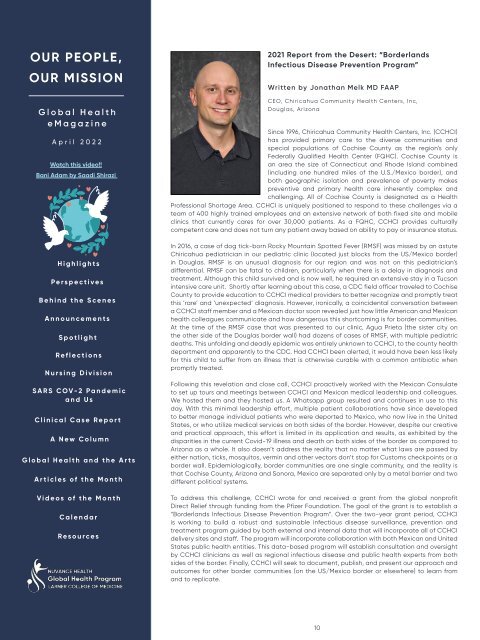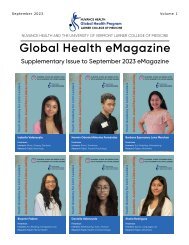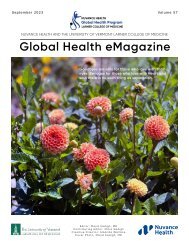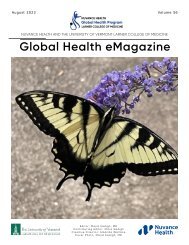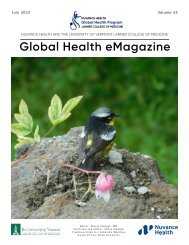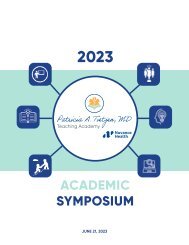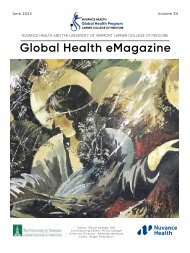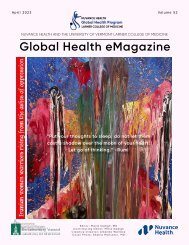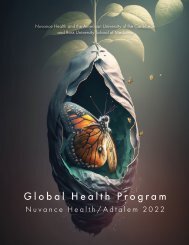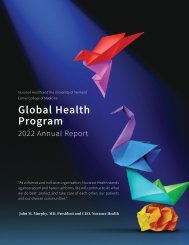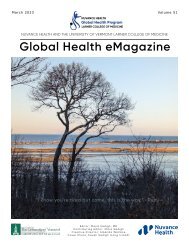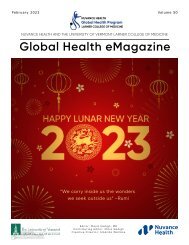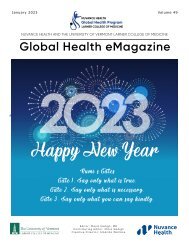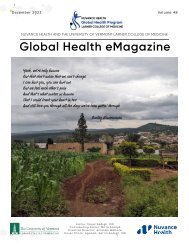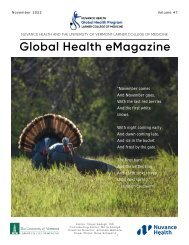April_eMagazine Volume 40
Create successful ePaper yourself
Turn your PDF publications into a flip-book with our unique Google optimized e-Paper software.
OUR PEOPLE,<br />
OUR MISSION<br />
Global Health<br />
<strong>eMagazine</strong><br />
<strong>April</strong> 2022<br />
Watch this video!!<br />
Bani Adam by Saadi Shirazi<br />
Highlights<br />
Perspectives<br />
Behind the Scenes<br />
Announcements<br />
Spotlight<br />
Reflections<br />
Nursing Division<br />
SARS COV-2 Pandemic<br />
and Us<br />
Clinical Case Report<br />
A New Column<br />
Global Health and the Arts<br />
Articles of the Month<br />
Videos of the Month<br />
Calendar<br />
Resources<br />
2021 Report from the Desert: “Borderlands<br />
Infectious Disease Prevention Program”<br />
Written by Jonathan Melk MD FAAP<br />
CEO, Chiricahua Community Health Centers, Inc,<br />
Douglas, Arizona<br />
Since 1996, Chiricahua Community Health Centers, Inc. (CCHCI)<br />
has provided primary care to the diverse communities and<br />
special populations of Cochise County as the region’s only<br />
Federally Qualified Health Center (FQHC). Cochise County is<br />
an area the size of Connecticut and Rhode Island combined<br />
(including one hundred miles of the U.S./Mexico border), and<br />
both geographic isolation and prevalence of poverty makes<br />
preventive and primary health care inherently complex and<br />
challenging. All of Cochise County is designated as a Health<br />
Professional Shortage Area. CCHCI is uniquely positioned to respond to these challenges via a<br />
team of <strong>40</strong>0 highly trained employees and an extensive network of both fixed site and mobile<br />
clinics that currently cares for over 30,000 patients. As a FQHC, CCHCI provides culturally<br />
competent care and does not turn any patient away based on ability to pay or insurance status.<br />
In 2016, a case of dog tick-born Rocky Mountain Spotted Fever (RMSF) was missed by an astute<br />
Chiricahua pediatrician in our pediatric clinic (located just blocks from the US/Mexico border)<br />
in Douglas. RMSF is an unusual diagnosis for our region and was not on this pediatrician’s<br />
differential. RMSF can be fatal to children, particularly when there is a delay in diagnosis and<br />
treatment. Although this child survived and is now well, he required an extensive stay in a Tucson<br />
intensive care unit. Shortly after learning about this case, a CDC field officer traveled to Cochise<br />
County to provide education to CCHCI medical providers to better recognize and promptly treat<br />
this ‘rare’ and ‘unexpected’ diagnosis. However, ironically, a coincidental conversation between<br />
a CCHCI staff member and a Mexican doctor soon revealed just how little American and Mexican<br />
health colleagues communicate and how dangerous this shortcoming is for border communities.<br />
At the time of the RMSF case that was presented to our clinic, Agua Prieta (the sister city on<br />
the other side of the Douglas border wall) had dozens of cases of RMSF, with multiple pediatric<br />
deaths. This unfolding and deadly epidemic was entirely unknown to CCHCI, to the county health<br />
department and apparently to the CDC. Had CCHCI been alerted, it would have been less likely<br />
for this child to suffer from an illness that is otherwise curable with a common antibiotic when<br />
promptly treated.<br />
Following this revelation and close call, CCHCI proactively worked with the Mexican Consulate<br />
to set up tours and meetings between CCHCI and Mexican medical leadership and colleagues.<br />
We hosted them and they hosted us. A Whatsapp group resulted and continues in use to this<br />
day. With this minimal leadership effort, multiple patient collaborations have since developed<br />
to better manage individual patients who were deported to Mexico, who now live in the United<br />
States, or who utilize medical services on both sides of the border. However, despite our creative<br />
and practical approach, this effort is limited in its application and results, as exhibited by the<br />
disparities in the current Covid-19 illness and death on both sides of the border as compared to<br />
Arizona as a whole. It also doesn’t address the reality that no matter what laws are passed by<br />
either nation, ticks, mosquitos, vermin and other vectors don’t stop for Customs checkpoints or a<br />
border wall. Epidemiologically, border communities are one single community, and the reality is<br />
that Cochise County, Arizona and Sonora, Mexico are separated only by a metal barrier and two<br />
different political systems.<br />
To address this challenge, CCHCI wrote for and received a grant from the global nonprofit<br />
Direct Relief through funding from the Pfizer Foundation. The goal of the grant is to establish a<br />
“Borderlands Infectious Disease Prevention Program”. Over the two-year grant period, CCHCI<br />
is working to build a robust and sustainable infectious disease surveillance, prevention and<br />
treatment program guided by both external and internal data that will incorporate all of CCHCI<br />
delivery sites and staff. The program will incorporate collaboration with both Mexican and United<br />
States public health entities. This data-based program will establish consultation and oversight<br />
by CCHCI clinicians as well as regional infectious disease and public health experts from both<br />
sides of the border. Finally, CCHCI will seek to document, publish, and present our approach and<br />
outcomes for other border communities (on the US/Mexico border or elsewhere) to learn from<br />
and to replicate.<br />
10


